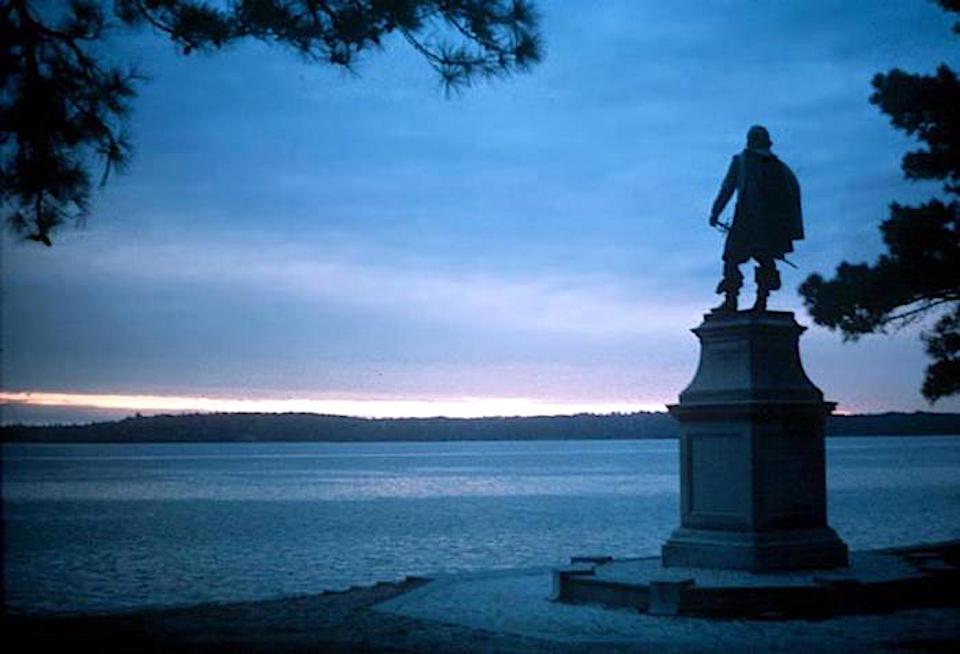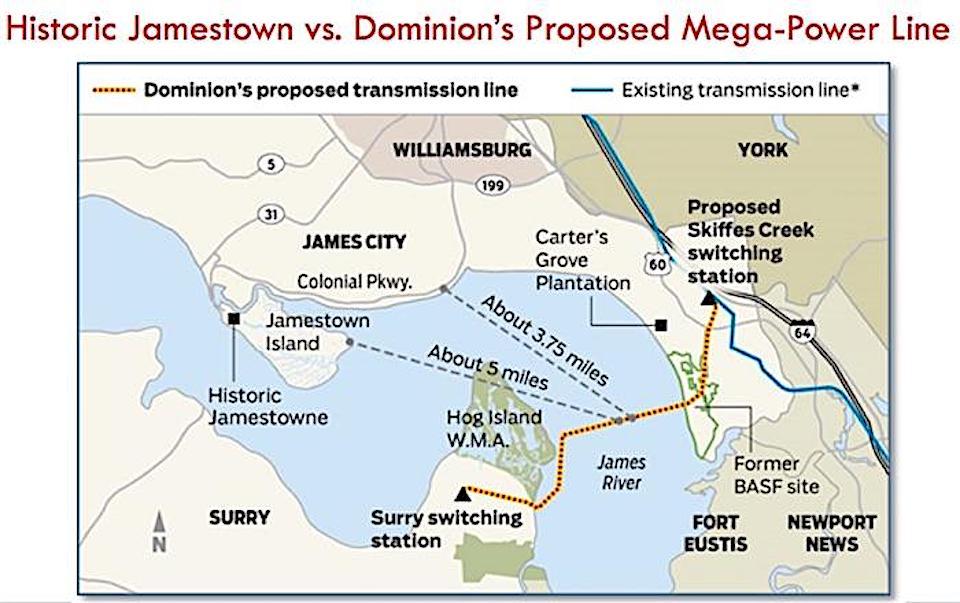
A federal appellate court has halted a project that would erect a roughly 7-mile-long line of transmission towers down the James River near Historic Jamestowne/NPS
Editor's note: This updates to reflect that the transmission towers have been put in place, and rephrases the text to reflect that.
A federal appellate court, holding that the U.S. Army Corps of Engineers should have prepared an environmental impact statement on a project to erect a 7-mile-long line of transmission towers through the James River near Historic Jamestowne, on Friday ordered the permit for the project to be withdrawn. However, with the construction virtually completed, what the ruling will lead to remains uncertain.
The project, which the Obama administration had objected to, was enthusiastically supported by the Trump administration and former Interior Secretary Ryan Zinke. But a unanimous court held that the Corps essentially looked the other way when serious concerns were raised.
"We don't know what's going to happen next," said Pam Goddard, the Chesapeake & Virginia Program director for the National Parks Conservation Association. The ruling returns the matter to the lower court, where the judge could "tell them to turn off the power, you shouldn't have built this," added Goddard
Former National Park Service Director Jon Jarvis in 2017 had said in a letter to the Army Corps of Engineers that the project, which would erect nearly 300-foot-high towers through the James River within sight of Historic Jamestowne and Colonial National Historical Park, would cause "severe and unacceptable damage to this historically important area and the irreplaceable and iconic resources within it."
Dominion Virginia Power maintained that its Surry-Skiffes Creek-Whealton Transmission Line, which crosses the river between Surry and James City counties, was the best way to maintain a healthy power grid in the area. But conservation groups, including the National Trust for Historic Preservation, the National Parks Conservation Association, and Preservation Virginia, maintained that there were less-damaging solutions -- burying the lines under the river, for instance -- that wouldn't need to span the river and invade the historic setting.
Alison Zemanski Heis, an NPCA spokesperson, said Friday afternoon that "the construction is nearly completed and Dominion turned the power on for the line yesterday."
In writing the court's opinion (attached below), Circuit Judge David Tatel said the National Environmental Policy Act requires an EIS to be completed when a "major" construction project could pose environmental consequences or impacts on “important historic . . . aspects of our national heritage.”
"The U.S. Army Corps of Engineers granted a permit allowing a utility company to build a series of electrical transmission towers across the historic James River, from whose waters Captain John Smith explored the New World, and it did so without preparing an EIS because it found that the project would have 'no significant impact' on the historic treasures along the river," the circuit judge wrote. "As explained below, however, the Corps’s 'no significant impact' finding was arbitrary and capricious: important questions about both the Corps’s chosen methodology and the scope of the project’s impact remain unanswered, and federal and state agencies with relevant expertise harbor serious misgivings about locating a
project of this magnitude in a region of such singular importance to the nation’s history."
The following video created by the National Trust for Historic Preservation depicts how the transmission line would appear if built.
Central to the issue was the move by Dominion to decomission two coal-fired power plants at Yorktown in Surry County. While the utility sees a future where more power will come from solar and nuclear, until that day, it believes there's a need to shore-up its power grid, and the transmission line was seen as key to that move.
Dominion had agreed to spend nearly $100 million on mitigation projects to "support, preserve, and/or enhance the historic character or viewshed of the Jamestown Settlement" and provide additional educational and interpretive programs to seawalls to protect Fort Monroe National Monument from sea level rise and efforts to "ensure that human skeletal remains and associated funerary objects encountered ... (are) treated in accordance with the Regulations Governing Permits for the Archaeological Removal of Human Remains."

This map prepared by the National Parks Conservation Association shows where the proposed transmission line would run and how close it would be to various units of the National Park System/NPCA
Despite the utility's mitigation plan, the document did not mollify groups that were consulted as required under Section 106 of the National Historic Preservation Act.
"As you know, the majority of consulting parties believe the adverse effects of this undertaking on the nationally significant historic properties cannot be appropriately mitigated," wrote Reid Nelson, director of the Office of Federal Agency Programs for the Advisory Council on Historic Preservation, in a May 2, 2017, letter to the Corps. "It is our hope that the studies and projects required by the MOA will limit long-term and cumulative effects and ultimately lead to the reversal of the direct and indirect effects by placing the overhead transmission line with a buried line under the James River."
Also objecting to the way the Corps cleared the way for the project was the National Trust for Historic Preservation, where Sharee Williamson, associate general counsel, in May 2017 wrote the Corps a 53-page letter outlining why that organization believed the Corps failed to meet the requirements under the National Environmental Policy Act.
Noting that the Trust had hired a Boston engineering firm that came up with a handful of alternatives that would meet the utility's stated goals without the need for a river-crossing transmission line, and that those alternatives were summarily dismissed, she wrote that, "(T)he Army Corps’ and Dominion’s stonewalling and failure to share information is inappropriate. Basing a permit decision on research conducted behind closed doors in an untransparent process simply does not comply with NEPA’s review requirements. Preparation of an EIS would allow the full and public review of project alternatives that NEPA requires."
On Friday, the court's decision, which ordered the Corps to prepare an EIS, was applauded by Theresa Pierno, NPCA's president and CEO, despite the fact that the construction of the line was nearly complete.
“Today’s ruling is a major victory for the preservation of historic Jamestown and all we continue to learn from this place,” she said. “The Army Corps cut corners in approving this permit and Jamestown and the surrounding national park landscape are paying the price. The court’s ruling follows the will of the people and all who care about our national park sites.”
Goddard said the ruling set a precedent that could be used in other cases involving intrusions in the National Park System
According to Judge Tatel, objections to the project included a specialist at the Department of Energy’s Argonne National Laboratory who "found the Corps’s analyses 'scientifically unsound' and 'completely contrary to accepted professional practice.'”
The 26-page ruling, which specifically directed the Corps to consider Clean Water Act and National Historic Preservation Act in re-evaluating the project's impacts, cited a litinany of objections to the Corps' methodology and decision-making.
"The (Park) Service repeatedly communicated its concerns to the Corps, and its own management plan requires that the “visual and historical integrity of the visitor experience” be “maximize[d]” and that all new utility lines be installed underground. And the list goes on. Industrial Economics, Inc., a consultant retained by the Park Service, feared that the Project could 'have implications for successful future designation [of Jamestown] as a UNESCO World Heritage Site.' The Virginia Department of Historic Resources warned of 'irreparabl[e] alter[ation] [of] the character of the area.' Members of Congress, delegates to the Virginia Assembly, the Keeper of the National Historic Register, and the Council on Environmental Quality all voiced similar reservations. The non-profit Coalition to Protect America’s National Parks, comprising current and former Park Service employees, pleaded, as did a bevy of other organizations, that '[t]he Corps owes . . . to this and future generations of Americans to protect the place where ‘America Began.’”
In defending its decision, the Corps maintained that "because the Park Service is a component of the Interior Department, Secretary Zinke’s letter approving the Project, in the district court’s words, 'effectively withdrew' the Service’s 'previous stance that an EIS was required,'" the judge noted. "We disagree. For one thing, even if the Zinke letter did withdraw the Service’s opposition, numerous other groups remained adamantly opposed. We are unsure, moreover, whether the Zinke letter actually responds to the Park Service’s concerns."
The ruling also asked, rhetorically, why the Corps found that Secretary Zinke's letter endorsing the project erased the concerns voiced by his predecessor, Sally Jewel, who strongly opposed the project in her own letter in one of her last acts in office.
"... in our view, that two Interior Secretaries had diametrically different views about the same project on the same facts simply reinforces its controversial nature," Judge Tatel wrote.






Comments
A huge win for the NPS. NPS fought the right fight until Zinke undercut them in 2017. It was an arrogant and cowardly act by Zinke and he wondered why he wasn't respected by "his troops".
Take the towers down !!
Dominion couldn't buy off everyone and the Corps should have just done the EIS but didn't want to because it would "delay" the project. Bad move.
An EIS wouldn't have actually delayed the project. It already took the Corps five plus years to get to a decision (under this Administration they'd only have two years per an infrastructure EO from August 2017!). The case is good clarification on laws/regulations (e.g. NEPA, NHPA) that have been unclear for far too long.
This is a classic example why regulated utilities should not be in the position of building controversial infrastucture projects without showing load factor justification. Most utilities, including Dominion operate at load factors in the 50% range. This means that they already have facilities to meet the energy requirements of their current customers, but actually only use them 50% of the time to deliver energy on average. Yet utilities (such as Dominion) make their profit on continually building new infrastructure, not on the selling of energy. So if the current infrastructure is utilized only 50% of the time, how do they justify adding new infrastructure that they need to continue their profit. It's quite simple, assume the public and the regulators don't understand load factor, and press the case for new infrastructure to meet the peak power needs during that one summer afternoon when the system require more capacity.
However, if the State Corporation Commission require Dominion (and other utilities to juestify the infrastructure based on load factor test, that is, they need to show that they are already oerating at high load factor (say between 70 - 80%), then Dominion would be forced to focus on other things first before submitting a transmission line, like using solar and battery backuo, energy efficiency, DSM and Demand Response to achieve higher load factor long before, such a transmission line could or should ever be built. Sadly Dominion is counting on the public and the state energy regulators, not to understand load factor, such that they can continue building uneeded infrastructure to maintain their profits.